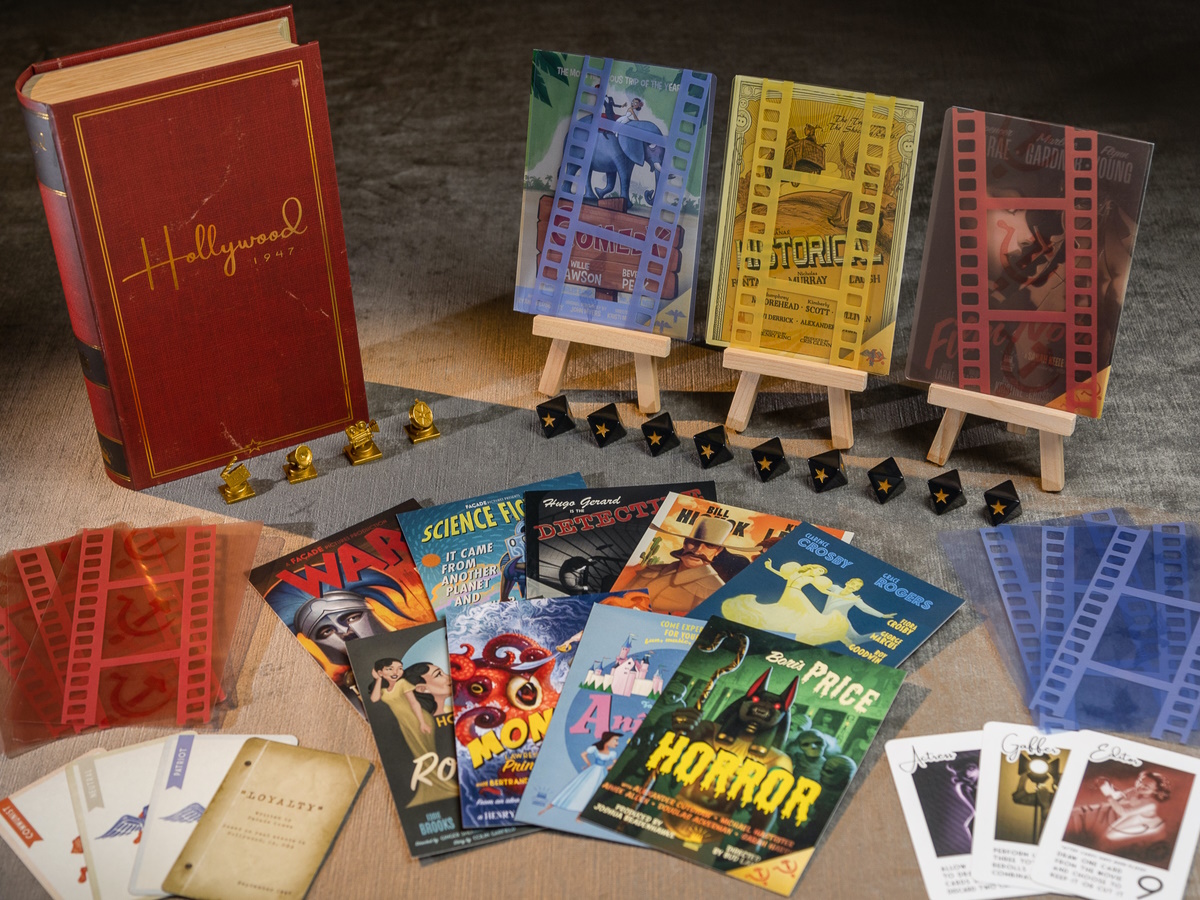Welcome to the great city of Hollywood in 1947. Great ideas for great movies are being thought up, and as those movies go into production, some people see it as a perfect path to push their agenda. Do you trust your coworkers in your studio, or are they trying to tear down all you love by including propaganda in the next Hollywood blockbuster?
What Is Hollywood 1947?
Hollywood 1947 is a social deduction and strategy game for one to nine players, ages fourteen and up, and takes anywhere from 20 to 40 minutes to play. It’s currently seeking funding on Kickstarter, with a pledge level of $27 for a copy of the game. It is based on social deduction with some light strategy thrown in. The premise of the game comes from the Facade Games’ Dark Cities series, featuring a particular location and time period. In this case, you are playing in Hollywood during the height of the Red Scare, when everyone suspected everyone else of being spies for communist regimes.

Hollywood 1947 was designed by Travis and Holly Hancock and published by Facade Games, with illustrations primarily by Sarah Keele. Some illustrations are by Ryan Goldsberry, and a costume designer illustrated the Costumes Expansion that is included with every Kickstarter purchase. The preview version of the game I played did not include any of the items from the Deluxe version being offered on Kickstarter currently and covered just the base game.
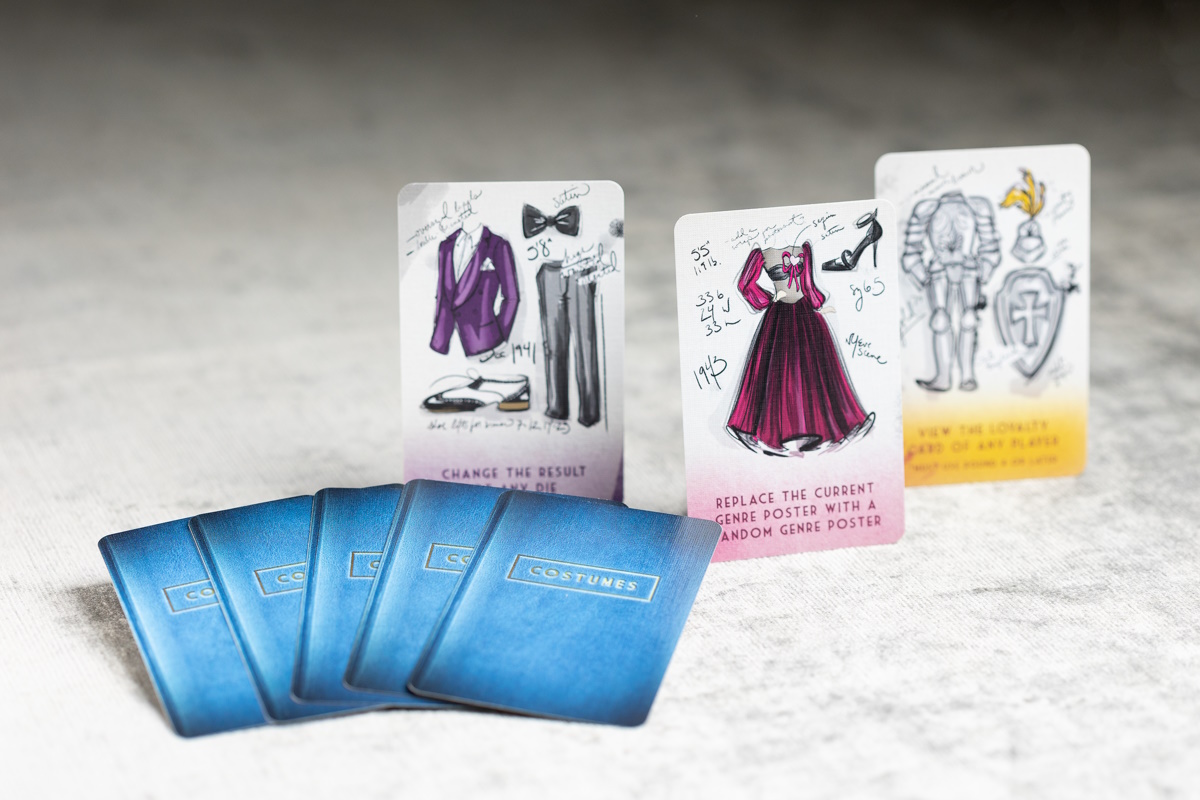
The Kickstarter campaign highlights the Deluxe edition well, as it will include additional jobs and movie posters that can add new twists to the game. As with most social deduction games, these additional items can add to the replayability a lot. As we will talk about, movie posters are typically just eye candy for the round and provide your starting propaganda, but these stretch goal posters actually add new rules while they are in play. This is a fun element that can add to the replayability of the game.
New to Kickstarter? Check out our crowdfunding primer.
Hollywood 1947 Components
Note: My review is based on a preview copy, so it is subject to change and may not reflect the final component quality. I also did not have any of the deluxe components, so any information on them is based on the Kickstarter campaign.
- 9 loyalty cards
- 9 job cards
- 15 genre posters
- 9 film strips
- 9 custom star dice
- 4 plastic movie tokens
- 60 propaganda cards
- 1 box shaped like a book
The Kickstarter campaign does offer a Deluxe Edition that adds several new items as well as a few upgrades. The plastic tokens will be replaced with metal versions, including an extra token. There are also 3 additional jobs, wooden tokens to go with one of those jobs, and three additional movie genre posters that have additional rules for the round they are used in.

Facade Games definitely gets the presentation right! I love the hardback book format they have chosen for their games, and their dedication to creating games that fit in the mold they are currently using. Hollywood 1947 follows their existing formula coming in a burgundy box shaped like a book. When you open the cover, you find all the components neatly tucked away in their own spots inside. As a social deduction game, most of the components are cards, but there are a few extra items that fit neatly with the theme.

The movie genre posters are terrific, and the art is spot-on with the overall feel of the game itself. Each poster features a movie genre laid out like a real movie poster from the period. At the bottom corner of each poster is a symbol indicating if the movie starts out as more patriotic or communist.
There are also film strips, which are translucent plastic cards you can put over the poster at the end of the round to indicate which side won the round. You have film strips for patriots, communists, and the rising star, which is a role in certain games whose goal is to ensure the sides are tied.
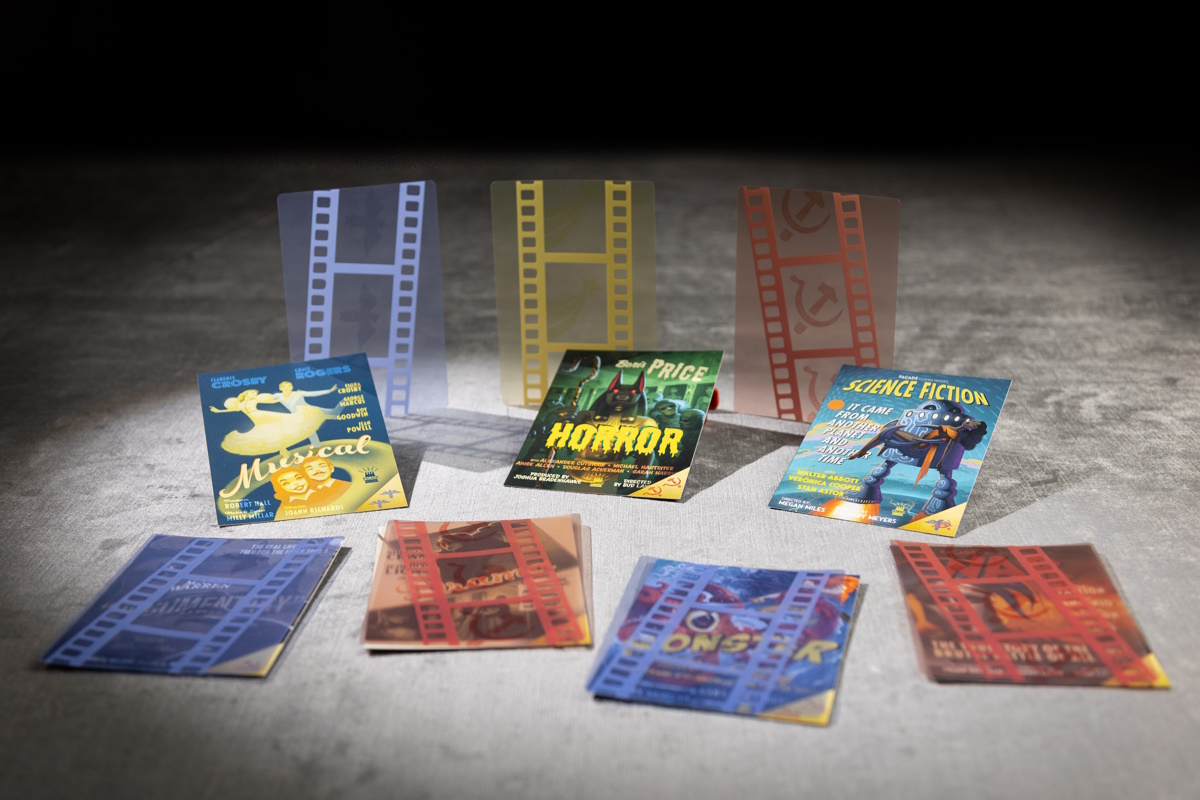
The dice and tokens are well made and fit with the theme of the game also. The dice are eight-sided and feature either a blank face or a gold star, and depending on what is showing on your die, you are able to contribute to the propaganda surrounding the current movie. The tokens are handed out by the director to allow certain players to play additional propaganda cards. They are iconic movie shapes, including a movie camera, film reel, and clapboard.

There are several types of cards included in the game. There is one job card per player, which gives the player specific tasks they can perform during each round. Similarly, there is one loyalty card per player to assign your loyalty to the patriots, communists, or, in certain situations, make you the rising star. Finally, the propaganda cards are used in each round to try to win that movie for your side.

Overall, the components are well thought out and add to the mood of the game. Facade Games also does a good job of helping you organize your components, such as including a tuck box for the cards. These thoughtful additions come in handy with the small size of the book box holding it all.
How to Play Hollywood 1947
You can download a copy of the rulebook here.
The Goal
I’ve always known about the red scare and McCarthyism, but I wasn’t really aware of how heavily it impacted Hollywood. I loved reading the historical blurb included with this game, but it didn’t really hit home how big it was in Hollywood until I pulled up McCarthyism on Wikipedia. The first thing I see is an actual propaganda piece from the early ’50s regarding communism in Hollywood! This game throws you right into the middle of that era. Each player is given a role as either a patriot or a communist, and your goal throughout the game is to get the most propaganda for your side into each movie.
There is also the role of a rising star that is included in certain player counts. The rising star is only out for themselves, and their goal is to ensure the game is tied right up to the final round, allowing them to become the sole winner of the game.
Setup
To start the game, shuffle the job cards and deal one card to each player. The players set the card face up in front of them, and this would be a good time to note who has the lowest numbered job card, as they will go first. The remaining job cards go into the center of the table to be used in various ways throughout the game. With nine players, there won’t be any extra job cards.
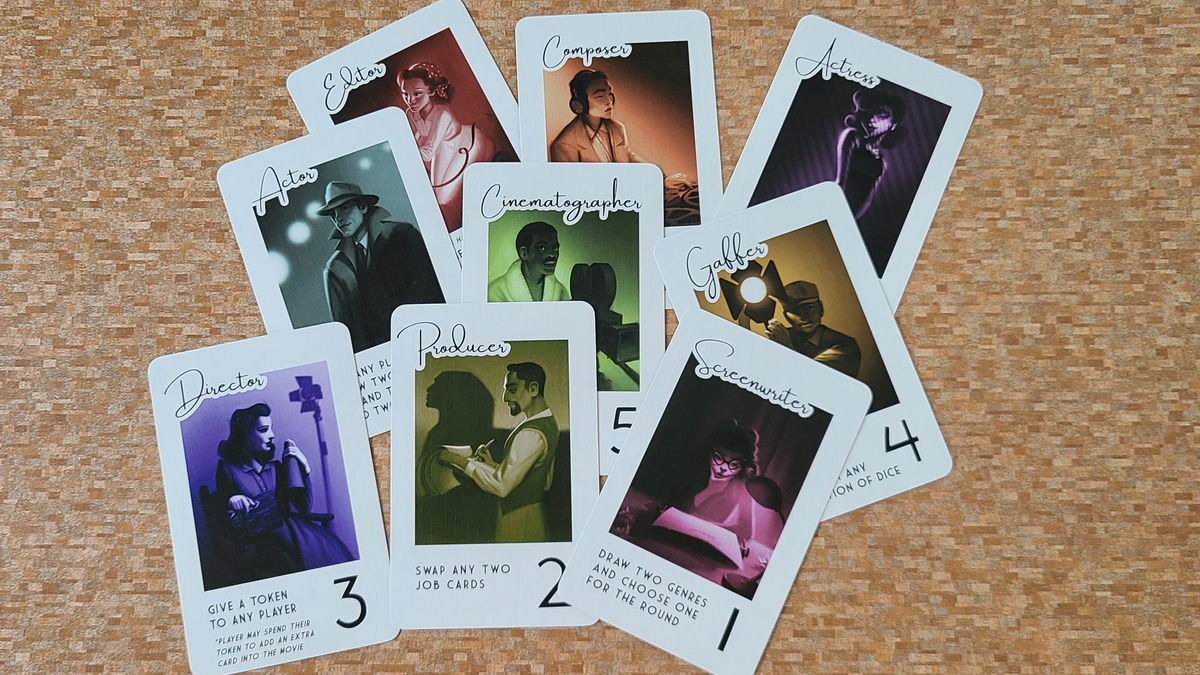
Next, create a loyalty deck based on the number of players you have. The instructions detail how many of each of the Patriot, Communist, and Rising Star cards to include based on player count. Deal one card to each player. Players keep their cards secret throughout the game and will use this loyalty as the basis for the propaganda cards they play.
Shuffle the propaganda cards and deal three to each player. The players will keep these hidden from the other players as well. Throughout the game when you discard a propaganda card to the discard pile, be sure to discard face down so no information is revealed about you and your loyalty.
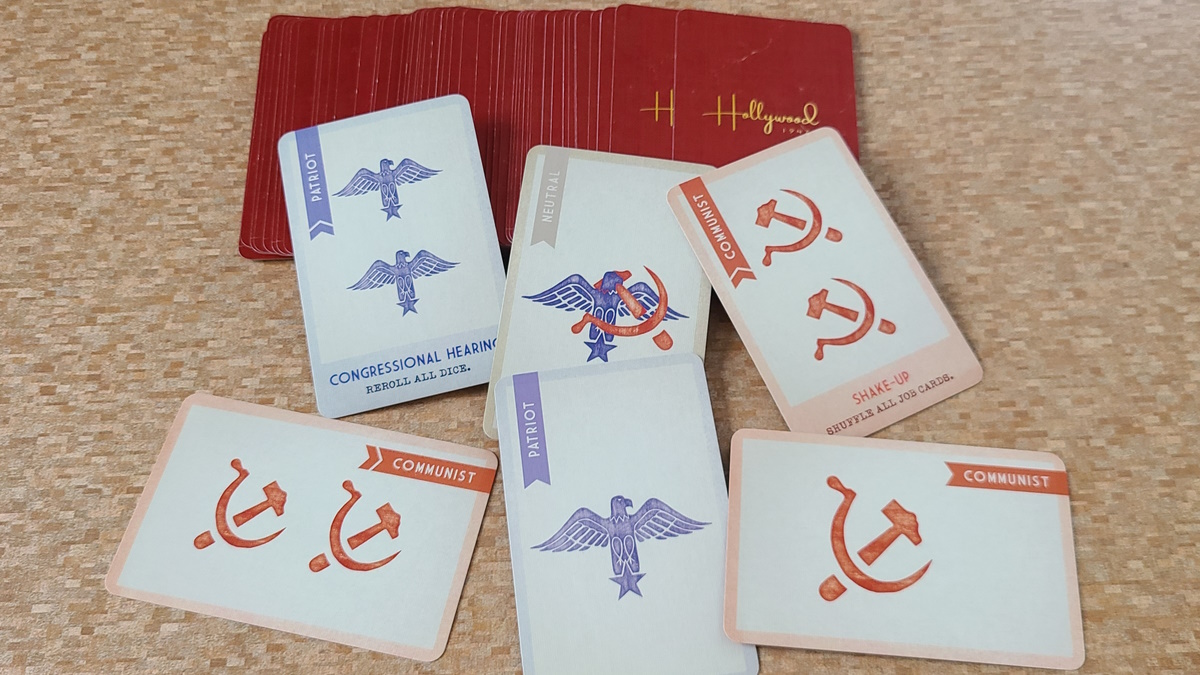
Give one eight-sided die to each player. The players roll the die and place it in front of them. If there is a star showing, they will be able to place a propaganda card this round. There are certain conditions that allow the die to be rerolled, but it is possible it will stay where it is for several rounds.
Finally, in good social deduction style, have all players close their eyes, and then have the communists open their eyes so they can see who their comrades are. You are ready to start the game.
Gameplay
Hollywood 1947 is played in a series of up to seven rounds. Each round represents the creation of a movie based on the movie genre poster, with the round progressing through Production, Post, and Premiere phases. The goal is to win the round for your team by ensuring you get the most propaganda cards on the movie to tip it in your favor.
The Production phase starts with the person holding the lowest numbered job card, and it progresses clockwise from that player. Each player will decide if they want to perform their job by doing what is printed on their job card. Job card number one is the Screenwriter, who gets to take two movie genre poster cards from the face-down pile and choose which one will be produced this round. If there is no screenwriter this round, or the screenwriter decides they don’t want to perform their job, the top genre card is revealed and used for the round.
If a player does not want to do their job, instead of performing their task, they can swap their job card with any extra job card in the middle of the table. This counts as their turn, though, so they won’t be able to do the new job until the next round. As there are only nine job cards, this option does not apply in a nine-player game. As you learn the game, you will find that different jobs have different tricks you can use them for. Some are obvious, such as the Composer, which allows you to add an extra card of your choice to the current movie.

A final option rather than performing your job, or swapping job cards, is rerolling any two dice. The player can pick any die in front of any player, including themselves, and roll that die again. They can only roll each die once, though, and they can choose to only roll one die as well.
Once everyone has taken an action during the Production phase, the round enters the Post phase. Each player with a star showing on their die in front of them gets to add a propaganda card from their hand facedown on top of the movie genre card. Also, any player who was given a token by the player with the director job during the Production phase can spend that token to add a card as well, even if they have already added a card or their die isn’t showing a star.
Then a card is taken from the top of the propaganda deck and placed facedown on the pile of cards on the movie poster. This pile is shuffled and a random propaganda card is removed to be discarded. If the player with the editor job decided to do their job this round, instead of discarding this first card, the editor can look at it and choose to discard it or put it back in the pile. If they put it back, the pile of propaganda cards is again shuffled, and another card is drawn at random to discard.
Now the round enters the Premiere phase when the cards are finally revealed, showing whether the movie is a patriotic masterpiece or a communist film trying to destroy all that the patriots have worked so hard for. Count the number of patriot and communist symbols on the cards, including the symbol on the movie poster card itself. In the event of a tie, the communists win. Put a translucent film strip for the winning group on top of the movie poster and set it aside for the end-game scoring.

Now check the propaganda cards that were on the movie poster. If any of them are showing a Congressional Hearing, then all players reroll their dice. Otherwise, the dice are left as-is from round to round. If there are any Shake Up communist propaganda cards, then all job cards, including any cards in the center of the table, are collected, shuffled, and redealt to the players. Finally, all players draw back up to three propaganda cards, and play proceeds to the next round.
Game End
The game ends when one side wins by collecting four movie posters. If you make it to the seventh round, which means you are currently tied three-three between the patriots and communists, and the seventh round is tied, or +1 to either side, and you have a Rising Star in your game, then the player that is the Rising Star is the sole winner. If either side wins the seventh round by +2 or more propaganda cards, then their side is the winner. Of course, if you do not have a Rising Star (1, 2, 3, or 5-player games) then the seventh round is scored normally, with a tie going to the communist side.
Why You Should Play Hollywood 1947
Facade Games has also included some tweaks for a one to three-player game to help the flow. It is also nice to see them involved with the game and the Kickstarter campaign very closely as some of the rules are being tweaked as the campaign goes on. My game group had a few questions come up as we played this game, and when I downloaded the rules a second time to check, I found our particular question had been addressed. Facade Games has proven itself to be responsive and committed to providing good quality games, and they’ve seen great success with Kickstarter.
My game group enjoyed playing the game with nine players. Games for a large number of people always seem to have some aspect of social deduction in them, and getting a new twist like Facade Games with us in Hollywood 1947 with the movie genre theme is a welcome addition. It did take us a few rounds to really get into the game and start trying to trick each other about who was and wasn’t a communist, but that did add a lot to the game and I would recommend that players really try to get into the intrigue of the game to make it more fun.
As I mentioned before, the preview copy of the game I played did not have the Costume Expansion that is being offered with Kickstarter purchases, and it also did not have the extra jobs or movie posters offered with the Deluxe Edition. I think the addition of movie posters with additional rules will really bring an extra layer to the rounds they are used, upping the enjoyment and replayability this game offers.
I have had good success and really enjoyed Facade Games products in the past, and Hollywood 1947 looks to continue that trend. I definitely recommend you check it out as it would be a good addition to any gamer’s collection, especially for those looking for games with higher player counts.
For more information or to make a pledge, visit the Hollywood 1947 Kickstarter page!
Click here to see all our tabletop game reviews.
![]() To subscribe to GeekDad’s tabletop gaming coverage, please copy this link and add it to your RSS reader.
To subscribe to GeekDad’s tabletop gaming coverage, please copy this link and add it to your RSS reader.
Disclosure: GeekDad received a copy of this game for review purposes.
